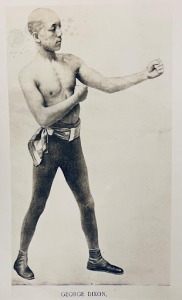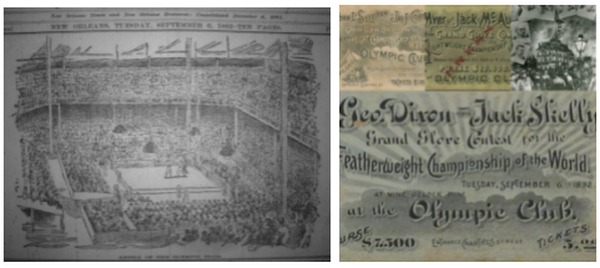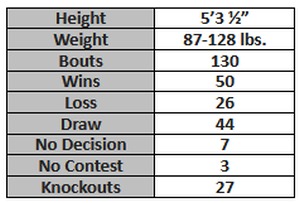
|
Philippines, 15 Dec 2025 |
Home >> News |
 |
||||
|
|
|
|
George Dixon: Professor of the Sweet Science of Bruising (Part 1 of 7, Undiluted Champions Series) By Emmanuel Rivera, RRT PhilBoxing.com Thu, 16 Sep 2021  September 16, 2021 Fremont, California They called him “Little Chocolate” due to his sweet moves atop the roped square. George Dixon was the progenitor of scientific boxing and whose smarts propelled him and the Sweet Science of Bruising to new heights. Dixon, once of Africville, Nova Scotia, Canada, later of Boston, Massachusetts then New York City, was the prototypic pugilist--adept at offense, defense, and everything in between. He was the inaugural bantamweight champion and the first featherweight titlist. For a brief time, he held both world crowns simultaneously. He was the first man to hold undiluted championships in any sport. He was one of the most respected boxers due to his powerful punches and silky moves. He is widely regarded as the inventor of shadowboxing and scientific training with a suspended heavy bag---methods still practiced today. George Dixon considered the jab as the premier weapon in boxing. Jeff Harding, the former light-heavyweight champion from Australia was probably channeling George Dixon (and the great Marvin Hagler) in the early 2000’s when he advised a fellow jab specialist Luisito Espinosa in San Jose, California, ”When in doubt, jab out!” Video of George Dixon versus Chester Leon https://www.youtube.com/watch?v=0CR0MrloO5w In 1886, the sixteen-year-old entered the professional ranks in his native Halifax, Nova Scotia. His manager, Tom O’Rourke, was in his corner in his fight against Cal McCarthy for the American version of the featherweight title at the Union Athletic Club in 1890 in Boston. The epic Dixon-McCarthy lasted 70 rounds only to be called a draw. In the same year, Dixon blasted British battler Nunc Wallace at the Pelican Club, the holder of England’s version of the 118-pound crown, within eighteen rounds. To prove his claim as a world-beater, he returned to the United States of America by knocking out bantamweight challenger Johnny Murphy. He repeated his victory over McCarthy by knockout in their rematch in 1891. Dixon, by 1892, grew out of the bantamweight division, abandoned the 118-pound crown, and campaigned mainly as a featherweight, thereafter. He annexed the featherweight crown he later held for 8 years, spawned by a fourteenth-round knockout of Fred Johnson in Coney Island in 1892. 
Dixon was part of the Carnival of Champions held at the Olympic Club in New Orleans, Louisiana where the heavyweight, lightweight and featherweight champions and top contenders were featured. Held during the Jim Crow era where African Americans were not allowed to fight Caucasian counterparts, Dixon was pitted against amateur champion Jack Skelly, who was white. So, on September 6, 1892, Dixon controlled Skelly, broke his nose, and ended the fight within eight rounds. Of note, Dixon reserved 700 tickets for black boxing fans. George Dixon was inducted into Canada's Sports Hall of Fame in 1955. In 2018, he was named one of the greatest 15 athletes in Nova Scotia's history, ranking sixth. Dixon was recognized by the inaugural The Ring Magazine Hall of Fame in 1956 and the International Boxing Hall of Fame in 1990. In his 1958 autobiography, Nathaniel “Nat” Fleisher of The Ring listed George Dixon as the #1 Bantamweight of all time---followed by Pete Herman, Kid Williams, Joe Lynch, Bud Taylor, Johnny Coulon, Pal Moore, Frankie Burns, Eddie Campi and Panama All Brown, respectively. In 1892, Dixon participated in the three-day Carnival of Champions which featured the heavyweight, lightweight and featherweight champions at the private, members-only Olympic Club in New Orleans, where most of boxing's top contenders met. Dixon was matched against the amateur champion Jack Skelly, who was white. Local NOLA broadsheets reported, “Dixon controlled the action from the start, broke Skelly's nose, and knocked him out in the eighth. White fans at the match reacted with shock and disgust, and to keep peace, the Olympic Club decided not to conduct any more mixed-race matches. The racist reaction to this fight led to limited black access to other matches, including heavyweight championships.” George Dixon became one of the finest boxers and was respected for both his intelligent tactics and sound upper and lower-body movements. He held on to the featherweight title for 8 years and was finally defeated by Terry McGovern in 1900 to wrest the crown. Terrible Terry again bested Dixon in a non-title rematch. Dixon continued fighting till 1906 but did not contend again for the crown. He died at the age of 38 on January 6, 1909. Pierce Egan, AJ Liebling, old-timers, and boxing fans alike would have been right if they dubbed him ‘The Pioneer’ instead. His final stats: 
****************************************************************************** Notes: The picture of George Dixon featured above is from the collection of the author and is in the public domain, as are the photos of the Carnival of Champions (circa 1892). Facts and information are excerpted and based on these sources: 1.'The Boxing Register' by James B. Roberts and Alexander G. Skutt, © 1999 by McBooks Press. All rights reserved. 2. ‘50 Years at Ringside’ by Nat Fleischer, ©1958. All rights reserved. 3. Nat Fleisher’s, All-Time Ring RECORD BOOK, 1941 Edition, ©1958. All rights reserved. Click here to view a list of other articles written by Emmanuel Rivera, RRT. |
|
|
PhilBoxing.com has been created to support every aspiring Filipino boxer and the Philippine boxing scene in general. Please send comments to feedback@philboxing.com |
PRIVATE POLICY | LEGAL DISCLAIMER
developed and maintained by dong secuya © 2025 philboxing.com. |